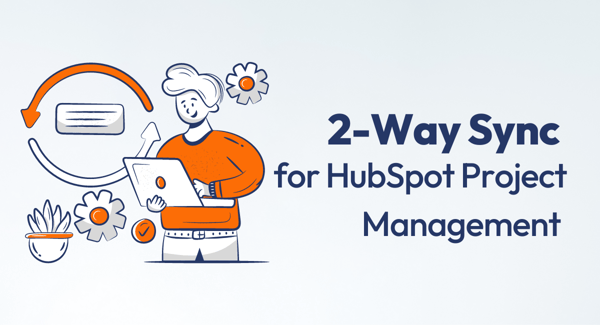Share this
Why You Need a 2-Way Sync for HubSpot Project Management
by Juliette Lagerweij on February 19, 2024

Teams who are already using the HubSpot platform for sales wonder if they can remain in the same digital environment for project management. And the short answer is yes.
You’re already in HubSpot anyway, so why not stick around and make things easier? To do that, you’ll need a native integration with your project management solution.
Successful HubSpot service businesses will use a project management app with native integration to optimize their deal to cash. This effectively keeps everything together in the digital HubSpot ecosystem:
“If you have a native integration within the applications you are using and it solves your operational challenge, go for it. That's the easiest, safest, and most intuitive way to sync data.” - HubSpot
However, not all native integrations are created equal.
Here’s why you specifically need a two-way integration to successfully leverage HubSpot project management.
What is HubSpot project management?
HubSpot project management means managing the entire project lifecycle without leaving HubSpot. While HubSpot itself does not offer full-fledged project management (it’s not their bread and butter), they do give you a leg-up on task management with their Projects feature.
HubSpot project management will require using HubSpot Projects and/or an integrated project management solution.
Various popular project management apps provide a native integration with HubSpot. However, not all of these provide a two-way flow of information, from HubSpot to the project management app and vice versa.
These one-way integrations leave much to be desired, as we’ll explain in the next section.
The problem with one-way integrations
“Native integrations can be great to automate certain workflows and serve a lot of common use cases. That said, they usually only work one way, and native integrations tend to be more in the data pushes category, not data syncs.” - HubSpot
If you want to seamlessly manage projects in HubSpot, not just any integration will do.
One-way integrations may give you basic functionality, but you won’t be able to effectively keep everything together, including contracts, time tracking, planning, etc within the HubSpot CRM. Here’s the problem:
One-way integrations limit what you can do on the project side and can create troublesome data silos. Like HubSpot says in the quote above, this type of integration technically qualifies as a data push, not a bonafide sync that you’d need for 360-degree visibility and control.
That’s because data will only move one way, instead of back and forth. Let’s take a look at how this applies to common HubSpot project management apps:
For example, Trello is a popular project management tool that offers an integration with HubSpot. But as you can see from their page on the App Marketplace, this only includes HubSpot workflows which will then be converted to task cards in Trello.
Nothing on the Trello end will translate to HubSpot, meaning sales will not be informed of anything that happens on the project side.
|
TRELLO DATA |
DATA FLOW |
HUBSPOT DATA |
|
Card |
← |
Workflows |
Here’s another example of a one-way HubSpot project management integration: Asana. Asana is a super-popular project management tool because it’s easy to use and offers loads of customization. However, again we have a one-way sync, where data only moves from HubSpot to Asana and not the other way around.
|
ASANA DATA |
DATA FLOW |
HUBSPOT DATA |
|
Tasks |
← |
Workflows |
These monodirectional syncs are indeed useful, but they’ll limit your level of cohesion between sales and projects. For instance, if someone on the sales side wants to create a quote based on a previous project budget, this information will have to be retrieved manually in the project management tool.
Whereas with a two-way integration, this information can be readily accessible without ever leaving HubSpot. In this scenario, you’d simply populate the quote with the accurate project data in a couple of clicks.
At the end of the day, one-way integrations do not provide a closed loop for both CRM and project management activity. This leaves you open to data security threats and inaccuracies from manual entry.
Better Project Management: Benefits of two-way software sync with HubSpot
“Having the right integration software to fit your needs is essential. It automates a huge part of your data management tasks and automatically syncs data between the applications in your software stack, drastically reducing the need for manual data entry, unifying data formats, and reducing the scope for error.” - HubSpot
Unlike a one-way sync, a two-way sync– also known as a bidirectional integration– will keep all the related data in a closed loop. Check out the following benefits of a two-way integration between the HubSpot CRM and your project management software:
Single source of truth
A two-way sync between a project management tool and the HubSpot CRM creates a single source of truth for the daily operations of service businesses. This will help promote transparency organization-wide, as well as supreme visibility, and a more holistic picture of business performance.
Increased productivity
In the two-way sync scenario, no one must jump between different solutions to find the correct information or complete a task. Instead, project data and customer data are easily accessible. And because you can automate more of your admin in a two-way sync environment, teams spend less time on the minutia.
Increased profitability
Because of the increased efficiency of a two-way integration, you’ll be able to find opportunities to increase your project profitability. This can include insights from time and expense data, which will cover your sales and marketing (HubSpot) and your project side. You will also be able to automate more menial admin processes, as these are more easily configured with the two-way flow of data. Finally, you’ll benefit from better reporting and analytics from a larger data store, so you can learn how to increase your project profit margins and where you might be getting it wrong.
Get started quicker
Everything is faster with a two-way HubSpot integration. You can start your project planning and developing your milestones before the deal is officially closed. Plus, when you go to create the project, it will automatically get populated with all the necessary customer data from HubSpot.
Accurate time tracking
Get paid for every hour that goes beyond what’s covered in your service agreement. In a two-way sync with project management tools like PSOhub, you can track time directly in the Service Hub.
Painless sales-to-project handoff
Versus a one-way sync, a bidirectional HubSpot project management integration will create cohesion between sales and project management. Both sides can view status updates in the HubSpot feed and receive automated alerts for important lynch points, i.e. contract sent, contract signed, etc.
Better invoice management
A two-way HubSpot project management integration can enable better invoice management. Both sales and projects can use the same system, which can be entirely automated depending on the tool you choose. That means spending less time actually creating invoices, reducing errors, and getting paid correctly, and on time.
Conclusion: What project management apps provide a two-way integration with HubSpot?
Now, you understand why it makes the most sense to use a two-way software integration for HubSpot project management. Otherwise, you’ll still need to import data manually and you won’t have cohesion between sales and projects. On top of that, you’ll be less efficient and less apt to learn from analytics due to data silos.
So, what project management tools offer the two-way integration we’ve been discussing?
At present, the highest-rated HubSpot project management apps with a two-way sync include Teamwork, PSOhub, and Wrike.
To confirm that a project management integration goes two ways, be sure to check out their page on the HubSpot app marketplace.
Look at the data sharing details to confirm the sync flows both ways, like what you see here below for the PSOhub HubSpot integration:
|
PSOHUB DATA |
DATA FLOW |
HUBSPOT DATA |
|
Project |
⇆ |
Deals |
|
Contact |
← |
Contacts |
|
Company |
← |
Companies |
|
Contact |
→ |
Transactional Email |
|
Timesheet |
→ |
Tickets |
|
Project contract line |
← |
Tickets |
As you can see, data is exchanged between both sides in the bidirectional sync. A two-way HubSpot project management integration like this one is your best bet to maintain a 360-degree view of your projects and customers in the most efficient way possible.
Share this
- Project Management (82)
- Productivity (61)
- Time Tracking (26)
- PSA Software (24)
- HubSpot (20)
- Resource Management (13)
- Invoicing (12)
- Salesforce (11)
- AI (7)
- Contract Management (7)
- Profitability (6)
- Gantt Chart (4)
- Microsoft Dynamics (4)
- Budget Management (3)
- Financial services (3)
- Integrations (3)
- Quickbooks (3)
- Quote (3)
- ROI (3)
- Traffic Management (3)
- collaboration (3)
- Consultancy (2)
- Digital Marketing & Advertising (2)
- Pipedrive (2)
- Work Management (2)
- About PSOhub (1)
- Automation (1)
- IT Companies (1)
- Risk Management (1)
- Ticket Sync (1)
- Workload Management (1)
- power bi (1)
- April 2025 (2)
- March 2025 (3)
- February 2025 (3)
- January 2025 (3)
- December 2024 (1)
- November 2024 (5)
- October 2024 (5)
- September 2024 (1)
- August 2024 (4)
- July 2024 (3)
- June 2024 (5)
- May 2024 (4)
- April 2024 (5)
- March 2024 (5)
- February 2024 (4)
- January 2024 (3)
- December 2023 (2)
- November 2023 (7)
- October 2023 (5)
- August 2023 (6)
- July 2023 (2)
- June 2023 (4)
- May 2023 (4)
- April 2023 (3)
- March 2023 (4)
- February 2023 (4)
- January 2023 (3)
- December 2022 (5)
- November 2022 (3)
- October 2022 (4)
- September 2022 (5)
- August 2022 (7)
- July 2022 (1)
- June 2022 (7)
- May 2022 (6)
- April 2022 (2)
- March 2022 (2)
- February 2022 (4)
- January 2022 (4)
- December 2021 (5)
- November 2021 (2)
- October 2021 (2)
- September 2021 (3)
- August 2021 (3)
- July 2021 (2)
- June 2021 (2)
- May 2021 (3)
- April 2021 (2)
- March 2021 (2)
- February 2021 (3)
- January 2021 (5)
- December 2020 (4)
- November 2020 (2)
- October 2020 (4)
- September 2020 (5)
- August 2020 (4)
- July 2020 (4)
- June 2020 (1)
- May 2020 (4)
- April 2020 (8)
- March 2020 (7)



